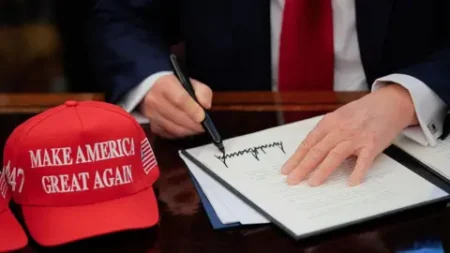In the arid landscape just outside Phoenix, Arizona, a remarkable endeavor is taking shape with far-reaching implications for the global economy. Amidst the backdrop of towering cactuses, a cutting-edge factory is being erected, one that will revolutionize semiconductor production, vital to numerous technologies and industries around the world. This critical facility is being built by TSMC, or Taiwan Semiconductor Manufacturing Company, a juggernaut in the semiconductor industry that has traditionally operated out of Taiwan, located just east of mainland China.
TSMC is not just any tech company; it holds a staggering 90% market share of the world’s advanced semiconductors—components critical for devices such as iPhones and computers. The construction of TSMC’s Arizona factory, known as “Fab 21,” heralds an important shift, marking the first time such advanced chips will be manufactured on American soil. In response to rising tariffs on imported chips, TSMC has committed to investing billions in this venture, reflecting both a significant business strategy and a planned response to geopolitical pressures.
The significance of industry secrets at this facility cannot be overstated. TSMC takes extreme measures to safeguard its proprietary technology. Blank materials and personal electronic devices are strictly prohibited on-site to prevent potential leaks of critical designs. The chip production process itself is intricate and labor-intensive, making the factory one of the most secured and vital establishments globally.
President Donald Trump frequently cites TSMC’s new factory as a testament to the “America First” policy that he champions. He views this facility as emblematic of efforts to reassert U.S. dominance in semiconductor production. Trump has stated, “We gradually lost the chip business, and now it’s almost exclusively in Taiwan. They stole it from us.” His narrative is that TSMC’s $100 billion investment in Arizona is a direct consequence of his administration’s tariffs, which he sees as key to prompting foreign companies to relocate manufacturing operations to the U.S.
This funding and attention to U.S. production are crucial amid rising tensions with China, which claims Taiwan as part of its territory, further intensifying the geopolitical stakes tied to this manufacturing site. As China observes the developments closely, Taiwan strategically relies on its semiconductor capacity, referring to it as its “Silicon Shield,” a defensive measure against any potential threats from its larger neighbor.
The TSMC Arizona facility starkly illustrates the contradiction inherent within Trump’s economic policies. While he seeks to reverse decades of U.S. economic integration with global partners, the manufacturing of advanced technology at this new site fundamentally requires cooperation and resources from around the world. It combines state-of-the-art techniques from various countries, highlighting the interconnected nature of today’s economy rather than a purely American-first approach.
Inside the facility, after undergoing stringent cleanliness protocols to minimize contamination, engineers and technicians work to fabricate silicon wafers containing billions of transistors. These transistors, the bedrock of modern technology, are now being produced through processes involving extreme ultraviolet light—an impressive yet complex technique that allows for the miniaturization of components, a critical driver behind the evolution of personal computing and artificial intelligence.
While TSMC is expanding its operations in the U.S., there are ongoing discussions within Taiwanese governmental circles about the implications of moving such advanced technology off the island. The delegation at TSMC asserts that much of the expansion was already in planning stages under previous provisions, such as the Biden administration’s Chips Act, indicating a nuanced view on the factors driving this significant economic shift.
However, the broader picture remains: the semiconductor supply chain operates on a global scale. It incorporates diverse resources—from silicon wafers sourced from Japan to advanced production machines from the Netherlands—indicating that no single nation can independently satisfy the demand for cutting-edge semiconductor technology. As such, tariff-driven policies could potentially complicate these international collaborations, emphasizing the need for strategic partnership at a global level.
In summary, TSMC’s push into the U.S. with its Arizona factory represents a microcosm of contemporary global interdependence amid increasing nationalistic policies. Trump’s vision of reviving American technological preeminence through tariffs and investments encounters the paradox of a reliance on global supply chains and international cooperation. As the factory rises from the Arizona soil, it encapsulates the ongoing struggle for dominance in the tech landscape, with Taiwan’s innovative capabilities standing at the helm of this defining industrial moment.











